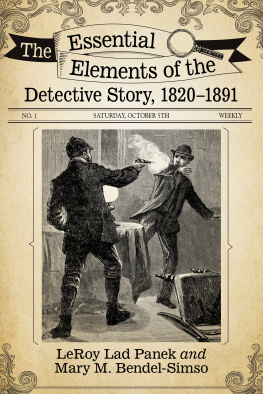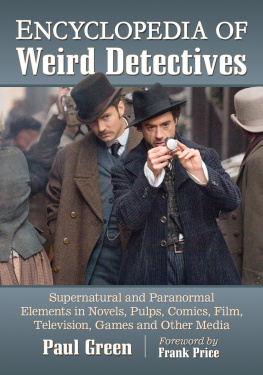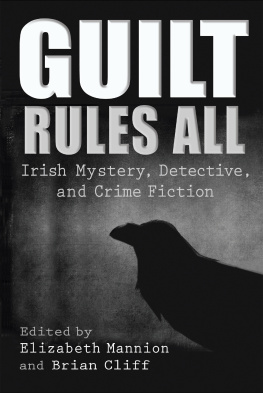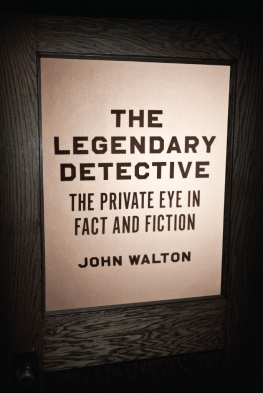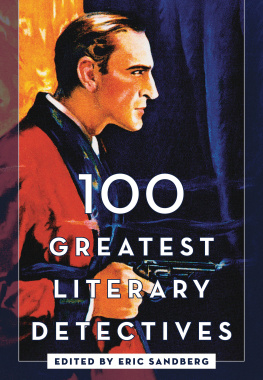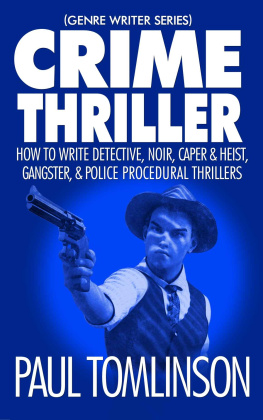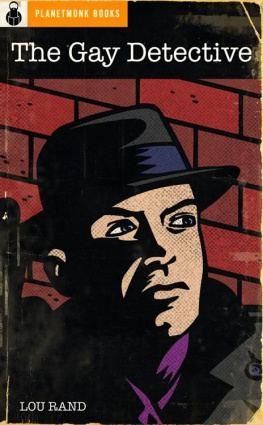
The Essential Elements of the Detective Story, 18201891
LEROY LAD PANEK and MARY M. BENDEL-SIMSO

McFarland & Company, Inc., Publishers
Jefferson, North Carolina
RECENT WORKS OF INTEREST AND FROM MCFARLAND
Early American Detective Stories: An Anthology, edited by LeRoy Lad Panek and Mary M. Bendel-Simso (2008; softcover 2014); After Sherlock Holmes: The Evolution of British and American Detective Stories, 18911914, by LeRoy Lad Panek (2014); Before Sherlock Holmes: How Magazines and Newspapers Invented the Detective Story, by LeRoy Lad Panek (2011); The Origins of the American Detective Story, by LeRoy Lad Panek (2006); Reading Early Hammett: A Critical Study of the Fiction Prior to The Maltese Falcon, by LeRoy Lad Panek (2004); The American Police Novel: A History, by LeRoy Lad Panek (2003)
LIBRARY OF CONGRESS CATALOGUING DATA ARE AVAILABLE
BRITISH LIBRARY CATALOGUING DATA ARE AVAILABLE
e-ISBN: 978-1-4766-2811-0
2017 LeRoy Lad Panek and Mary M. Bendel-Simso. All rights reserved
No part of this book may be reproduced or transmitted in any form or by any means, electronic or mechanical, including photocopying or recording, or by any information storage and retrieval system, without permission in writing from the publisher.
Front cover image of Gun Shot Argument, magnifying glass and newspaper border 2017 Roman Stoliarchuk/benoitb/iStock
McFarland & Company, Inc., Publishers
Box 611, Jefferson, North Carolina 28640
www.mcfarlandpub.com
For Penelope Taylor
INTRODUCTION
More than a decade ago, while looking for historical material about detectives in old issues of the New York Times and Washington Post online we found something we were not looking for. Sure there were news pieces about detectives in the 19th-century papers, but there were also pieces that were clearly fiction, pieces that were detective storiesfrom the 1830s onward. That was at a time when digitizing and online publishing of historical newspapers by private enterprises, states historical societies, universities, and the LIBRARY OF CONGRESS Chronicling America project were just beginning. These hitherto unavailable resources now provide access to an immense amount of information about a lot of thingsliterally millions of pages of magazines and newspapers printed in cities, towns, and even hamlets from Maine to California beginning in the 1830s. We started to look for detective stories in them. Then we also started looking at the books and magazines found on Google Books, various online periodical databases, and volume after volume of family story papers in library archives. We found that the total amount of new material available to anyone interested in popular fiction in 19th-century America was enormous and was becoming even more enormously enormous every year. We decided to start collecting the detective stories we found. But there were some problems. The first was to decide what was a detective story and what wasnt. Many of the stories we have discovered were labeled as detective stories in their original publications, so they werent a problem. But some werent. Many of those were about the actions of characters specifically called detectives, so they were easy. And then there were stories in which someone not called a detective (a lawyer, a physician, an amateur) does what detectives dosolves real or imagined crime problems. These were somewhat more problematic. Since we were dealing with very early popular literature, some of it from before the word detective was coined or current, we decided to err on the side of generosity. Incidentally we had to contend with the fact that current OCR programs cannot always distinguish between fs and ts in some old newsprint and include the word defective in searches for the word detective, and the necessity of sorting imaginary from real detectives in newspapers in which the word story can be used for news as well as for fiction. The excitement of discovering the first few detective stories in 19th-century papers led us to decide to catalog and eventually publish online every detective story printed in the United States before 1891, the date dictated by the publication of the first Sherlock Holmes short story and the beginning of what really turns out to be the rebirth of the detective story. We called our project The Westminster Detective Library and it can be found at https://wdl.mcdaniel.edu. Setting aside serial fiction (which also had a role to play in the history of the detective story), our first notion was that we would find maybe a hundred short stories. We reached five hundred. Then the total became a thousand. Now we are not sure where it will end. We are still looking forand findingnew stories to read, catalog, and put on the waiting list for processing and publishing online. We have put out of our minds for the time being that searchable databases exist for historical English and even Australian newspapersand the fact that we know that they contain detective stories. Limiting ourselves to American short stories is daunting enough for now.
One of the things we are doing in the pages below is taking a look at what we have collected so far and what it says about detective stories during what amounted to their formative years. There doubtless remain a trove of undiscovered stores; yet we still reckon that we have a pretty solid sample of 19th-century short detective fictionwell over 1,300 stories. That sample, we believe, reveals a great deal about both detective stories and 19th-century fiction in America. To a far lesser extent, it also says something about the detective story in Britain and France. The basic discovery that we have made is that newspapers played a vital role in the creation and development of the detective story. The 19th-century newspapers that are sources of the majority of the pieces we have collected were a lot different from the newspapers some people still remember. First of all, most towns in the U.S. had their own paper, like Orion Clemens Western Union in Hannibal, Missouri, where his brother, Mark Twain, worked. Indeed, one sign of being a town instead of a settlement or crossroads was having a newspaper. The year Tombstone, Arizona, became an official town its first paper, The Tombstone Epitaph, began publishing. Towns had papers with their names attached to the words gazette, news, reporter, citizen, sentinel, herald, bulletin, and press. Some attached a political party to the towns name, and some editor-publishers opted for something more colorfulthus The Sedalia Weekly Bazoo, White Cloud Chief, The Raftmans Journal, Catoctin Clarion, Alpena Argus, The Arizona Kicker, The Branding Iron, and The Ellensburg Dawn. Although lots of towns had newspapers, before the telegraph system fully developed there was precious little news to print from outside the local community. Of course there were always advertisementsadvertisements which take up more space than the copy in some papers. Most importantly for us, mid19th-century newspapers published fiction, a lot of it. Through the 1860s it is not unusual to find that the whole first page of the typical town newspaper in every section of the country consisted of a short story, with a poem and a local-interest piece thrown in. To date, no one has undertaken a comprehensive study of this mountain of fiction. That being said, even a brief survey shows three recurring types of fiction in mid-century American newspaper fiction: love stories, ghost stories, and detective stories. Many papers even added a separate headline (i.e., A Ghost Story) or inserted the genre of the story in the title of stories like Human Bones: A Modern Ghost Story in
Next page
